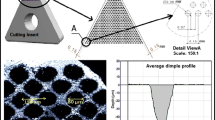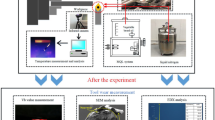Abstract
The heat generated during the machining of titanium alloys accumulates in the cutting area during machining. These high temperatures lead to tool wear, affect the quality of the machined surface, and alter the cutting force. In light of this, a new method for mixing vegetable oil additives is proposed herein, through the addition of graphene nanoparticles and sulfur-based extreme pressure (EP) additives to canola oil to improve the lubrication and cooling performance of the machining area. The optimum results were found for the combination of canola oil + graphene + sulfur-based EP additives, which effectively decreased the temperature of the cutting area and wear of cutting tools. In comparison to canola oil, the flank wear value decreased by 56.4%. Similarly, the surface roughness and cutting force when using the canola oil + graphene + sulfur-based EP additive were the lowest, exhibiting a decrease of 36.1% and 27.0%, respectively, in comparison to simple canola oil. The inorganic film produced by the EP additive molecule helps prevent direct contact between the tool and the workpiece, reducing tool wear and improving surface quality. Furthermore, adhered chips were also observed, with a layered morphology. Graphene shortens the length of the chip-adhesion layer (0.081 mm) and reduces adhesion wear. Elemental testing confirmed that graphene penetrates more easily into the manufacturing area, which is beneficial to reducing abrasive wear and the cutting force. In addition, the higher thermal conductivity of graphene will effectively reduce the temperature of the cutting area, which impedes the agglomeration of these chips. This weakens the adhesion of the chips to the surface of the workpiece.












Similar content being viewed by others

References
Benjamin DM, Sabarish VN, Hariharan M, Samuel RD (2018) On the benefits of sub-zero air supplemented minimum quantity lubrication systems: an experimental and mechanistic investigation on end milling of Ti-6-Al-4-V alloy. Tribol Int 119:464–473
Revuru RS, Posinasetti NR, Ramana V, Amrita M (2017) Application of cutting fluids in machining of titanium alloys—a review. Int J Adv Manuf Technol 91(5–8):2477–2498
Gaurav G, Sharma A, Dangayach GS, Meena ML (2020) Assessment of jojoba as a pure and nano-fluid base oil in minimum quantity lubrication (MQL) hard-turning of Ti-6Al-4V: a step towards sustainable machining. J Clean Prod 272:122553
Sankaranarayanan R, Hynes NRJ, Kumar JS, Krolczyk GM (2021) A comprehensive review on research developments of vegetable-oil based cutting fluids for sustainable machining challenge. J Manuf Process 67:286–313
Rahim EA, Sasahara H (2011) A study of the effect of palm oil as MQL lubricant on high speed drilling of titanium alloy. Tribol Int 44(3):309–317
Rahim EA, Sasahara H (2011) Investigation of tool wear and surface integrity on MQL machining of Ti-6AL-4V using biodegradable oil. Proc Inst Mech Eng B J Eng Manuf 225(9):1505–1511
Khan M, Mithu M, Dhar NR (2009) Effects of minimum quantity lubrication on turning AISI9310 alloy steel using vegetable oil-based cutting fluid. J Mater Process Technol 209(15–16):5573–5583
Wang Y, Li C, Zhang Y, Li B, Yang M, Zhang XP, Guo S, Liu G (2016) Experimental evaluation of the lubrication properties of the wheel/workpiece interface in MQL grinding with different nanofluids. Tribol Int 99:198–210
Khanna N, Agrawal C, Pimenov DY, Singla AK, Machado AR, Silva LRR, Gupta MK, Sarikaya M, Krolczyk GM (2021) Review on design and development of cryogenic machining setups for heat resistant alloys and composites. J Manuf Process 68:398–422
Maruda RW, Krolczyk GM, Niesłony P, Krolczyk JB, Legutko S (2016) Chip formation zone analysis during the turning of austenitic stainless steel 316L under MQCL cooling condition. Procedia Eng 149:297–304
Krolczyk GM, Maruda RW, Krolczyk JB, Niesłony P, Wojciechowskic S, Legutko S (2018) Parametric and nonparametric description of the surface topography in the dry and MQCL cutting conditions. Measurement 121:225–239
Eltaggaz A, Hegab H, Deiab I, Kishawy HA (2018) Hybrid nano-fluid-minimum quantity lubrication strategy for machining austempered ductile iron (ADI). Int J Interact Des Manuf 12(4):1273–1281
Su Y, Gong L, Li B, Liu ZQ, Chen DD (2016) Performance evaluation of nanofluid MQL with vegetable-based oil and ester oil as base fluids in turning. Int J Adv Manuf Technol 83(9–12):2083–2089
Rapeti P, Pasam VK, Gurram K, Revuru RS (2018) Performance evaluation of vegetable oil based nano cutting fluids in machining using grey relational analysis—a step towards sustainable manufacturing. J Clean Prod 172(3):2862–2875
Hadi M, Atefi R (2015) Effect of minimum quantity lubrication with gamma-Al2O3 nanoparticles on surface roughness in milling AISID3 steel. Indian J Sci Technol 8:296–300
Sharma N, Syed NA, Ray BC, Yadav S, Biswas K (2019) Wear behaviour of silica and alumina-based nanocomposites reinforced with multi walled carbon nanotubes and graphene nanoplatelets. Wear 418–419:290–304
Denver, CO, US (2004) Experimental comparison of vegetable and petroleum base oils in metalworking fluids using the tapping torque test. Japan-USA Symposium on Flexible Automation; JUSFA
Ozcelik B, Kuram E, Cetin MH, Demirbas E (2011) Experimental investigations of vegetable based cutting fluids with extreme pressure during turning of AISI 304L. Tribol Int 44(12):1864–1871
Maruda RW, Krolczyk GM, Wojciechowski S, Zak K, Habrat W, Nieslony P (2018) Effects of extreme pressure and anti-wear additives on surface topography and tool wear during MQCL turning of AISI 1045 steel. J Mech Sci Technol 32(4):1585–1591
Maruda RW, Krolczyk GM, Feldshtein E, Nieslony P, Tyliszczak B, Pusavec F (2016) Tool wear characterizations in finish turning of AISI 1045 carbon steel for MQCL conditions. Wear 372–373:54–67
Bai X, Li C, Dong L, Yin Q (2019) Experimental evaluation of the lubrication performances of different nanofluids for minimum quantity lubrication (MQL) in milling Ti-6Al-4V. The International Journal of Advanced Manufacturing Technology 101:1–15
Gajrani KK (2020) Assessment of cryo-MQL environment for machining of Ti-6Al-4V. J Manuf Process 60:494–502
Gaurav G, Sharma A, Dangayach G S, Meena ML (2020) Assessment of jojoba as a pure and nano-fluid base oil in minimum quantity lubrication (MQL) hard-turning of Ti-6Al-4V: a step towards sustainable machining. J Clean Prod 272:122553
Bertolini R, Ghiotti A, Bruschi S (2021) Graphene nanoplatelets as additives to MQL for improving tool life in machining Inconel 718 alloy. Wear 1:203656
Li C (2019) Summary of sulfurized additives Synthetic lubricants 46(3):23–26
Bermingham MJ, Kirsch J, Sun S, Palanisamy S, Dargusch MS (2011) New observations on tool life, cutting forces and chip morphology in cryogenic machining Ti-6Al-4V. Int J Mach Tools Manuf 51(6):500–511
Debnath S, Reddy MM, Yi QS (2014) Environmental friendly cutting fluids and cooling techniques in machining: a review. J Clean Prod 15(83):33–47
Li M, Yu TB, Zhang RC, Yang L, Li H, Wang WS (2018) MQL milling of TC4 alloy by dispersing graphene into vegetable oil-based cutting fluid. The International Journal of Advanced Manufacturing Technology 99(5–8):1735–1753
Singh R, Dureja JS, Dogra M, Gupta MK, Mia M, Song QH (2020) Wear behavior of textured tools under graphene-assisted minimum quantity lubrication system in machining Ti-6Al-4V Alloy. Tribol Int 145:106183
Fabrice D, Guillemet F (2002) New water soluble EP additive for environment friendly fluids. Industrial Lubrication & Tribology 54(6):285–290
Singh R, Dureja JS, Dogra M, Gupta MK, Mia M (2019) Influence of graphene-enriched nanofluids and textured tool on machining behavior of Ti-6Al-4V alloy. The International Journal of Advanced Manufacturing Technology 105(1):1685–1697
Babu MN, Anandan V, Muthukrishnan N, Arivalagar AA, Babu MD (2019) Evaluation of graphene based nano fluids with minimum quantity lubrication in turning of AISI D3 steel. SN Appl Sci 1(10):1–15
Cui X, Li CH, Zhang YB, Jia DZ, Zhao YJ (2019) Tribological properties under the grinding wheel and workpiece interface by using graphene nanofluid lubricant. Int J Adv Manuf Technol 104(9–12):3943–3958
Amrita M, Srikant RR, Sitaramaraju AV (2014) Performance evaluation of nanographite-based cutting fluid in machining process. Mater Manuf Processes 29:600–605
Funding
This study was financially supported by the National Natural Science Foundation of China (NSFC) (Grant NO. 51875367), LiaoNing Revitalization Talents Prograrn (Grant NO. XLYC2007011), Natural Science Foundation of Liaoning Province (Grant No. 2020-MS-234), Foundation of Liaoning Educational Committee (Grant No. JYT2020004), China Postdoctoral Science Foundation (Grant No. 2020M670790) and Shenyang Youth Science and technology innovation project (Grant No. RC190072).
Author information
Authors and Affiliations
Contributions
Ben Wang: Conceptualization, Methodology, Writing—Review & Editing. Quanwei Yang: Formal analysis, Writing—Original Draft. Jiawei Deng: Investigation. Ning Hou: Data curation. Xuezhi Wang: Supervision. Minghai Wang: Validation.
Corresponding author
Ethics declarations
Competing interests
The authors declare no competing interests.
Additional information
Publisher's Note
Springer Nature remains neutral with regard to jurisdictional claims in published maps and institutional affiliations.
Rights and permissions
About this article
Cite this article
Wang, B., Yang, Q., Deng, J. et al. Effect of graphene nanoparticles and sulfurized additives to MQL for the machining of Ti-6Al-4 V. Int J Adv Manuf Technol 119, 2911–2921 (2022). https://doi.org/10.1007/s00170-021-08348-w
Received:
Accepted:
Published:
Issue Date:
DOI: https://doi.org/10.1007/s00170-021-08348-w



